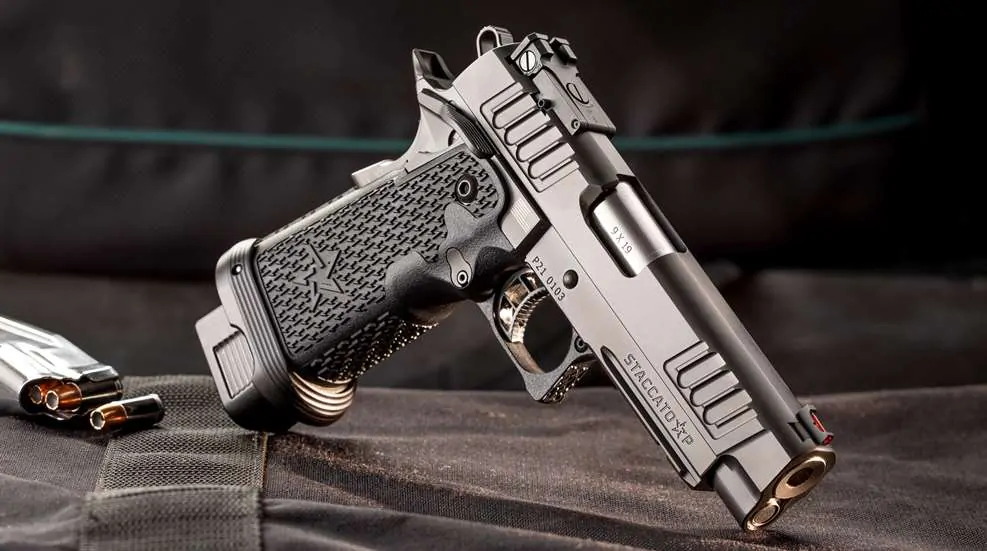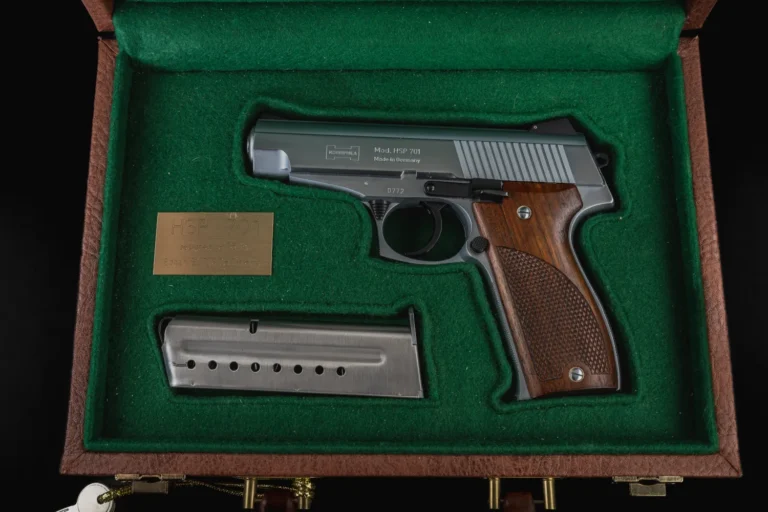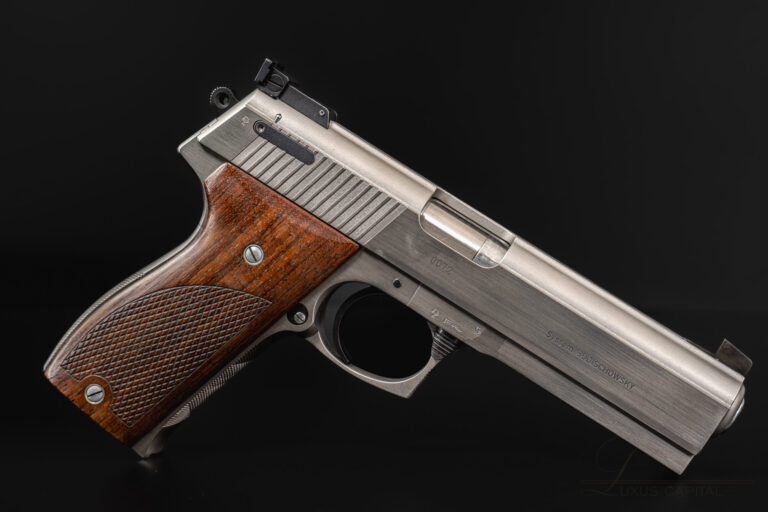The 2011-style pistol is the culmination of over a century’s worth of innovation, building upon the legendary 1911 platform that has captivated shooters worldwide with its reliability and design.
The inception of the 2011-style pistol marks a revolutionary step in firearms development, marrying the time-tested principles of its predecessor with contemporary needs. It brings forth a significant leap in functionality and adaptability, particularly in the dynamic spheres of competitive shooting and tactical operations.
Its enhanced double-stack magazine capacity, modular frame construction, and ergonomic refinements demonstrate a commitment to performance and shooter satisfaction. In this arena, where split seconds and precision matter, the 2011-style pistol has become an indispensable tool, pushing the boundaries of what is possible with a sidearm.
Key Manufacturers
A select few manufacturers have risen to prominence in the 2011-style market, each bringing their unique flair and specialized adaptations to the table. STI International, now rebranded as Staccato has blazed the trail, offering models that have become synonymous with excellence in both the competitive and tactical domains.
Triarc Systems follows with a reputation for meticulously crafted custom pistols that appeal to a discerning clientele seeking precision and individuality. Nighthawk Custom stands out for its luxurious approach, crafting pistols that are as much a status symbol as they are feats of engineering.
Lastly, Atlas Gunworks has carved out its niche by focusing on the competitive shooter, with offerings optimized for speed and accuracy that satisfy even the most demanding marksman. These manufacturers have not only contributed to the development of the 2011-style pistol but have also defined its role in modern firearms culture through their innovative designs and user-focused enhancements.
Historical Significance
The emergence and refinement of the 2011-style pistol encapsulate the trajectory of firearms evolution, driven by an ever-increasing demand for precision and capacity. This development journey echoes the shifting landscape of firearms technology and user expectations, particularly within competitive shooting circuits, such as those governed by the United States Practical Shooting Association (USPSA).
Its acceptance by law enforcement and tactical professionals underlines its reputation for steadfast performance and enhanced capacity, setting it apart from its contemporaries. The historical trajectory of the 2011-style pistol is not just a testament to its design prowess but also to the broader narrative of innovation in the face of changing operational landscapes and the relentless pursuit of perfection in firearms technology.
Early Adoption and Development
STI International’s pioneering efforts in refining the 1911 design gave rise to the 2011 platform, which marked a significant departure from the century-old blueprint of its progenitor. Their foray into modular frame technology and increased magazine capacity initiated a paradigm shift within the industry, prompting a wave of innovation and adaptation.
This early adoption of what were then radical ideas has set the stage for modern firearms manufacturing, where modularity and capacity are not just features but necessities. The foresight displayed by STI has paved the way for the 2011-style pistol to become a mainstay in the competitive and tactical arenas, showcasing the industry’s ability to evolve and adapt to the needs of advanced shooters.
Technological Innovations and Features
The 2011-style pistol stands at the forefront of firearm innovation, integrating advanced technological features that cater to various shooting disciplines. Its modular frame, which often combines robust steel with lightweight polymer, exemplifies the modern approach to firearms design—seeking to balance durability with ease of handling.
The reimagined grip ergonomics are a nod to the shooter’s need for comfort and control, essential in the high-stakes environment of competitive shooting. Moreover, the barrel and slide have been the subjects of extensive experimentation, with manufacturers exploring varying lengths, porting, fluting, and using advanced coatings to refine performance and aesthetic appeal.
The trigger mechanism, a critical interface between shooter and firearm, has been re-engineered to offer a range of configurations and customization options, allowing for a highly personalized shooting experience.
Frame and Grip Innovations
The transformation of the classic 1911 into the 2011-style pistol is most evident in the innovations seen in frame and grip design. Moving away from the solid steel frame of its predecessor, the 2011 utilizes a modular approach, often incorporating advanced polymers to reduce weight without compromising the structural integrity.
This has led to unprecedented customization, allowing shooters to achieve a personalized fit and feel—critical factors in competitive shooting where ergonomics can significantly influence performance. Enhanced grip textures and contours improve the shooter interface, providing superior control and reducing fatigue during prolonged use.
Such ergonomic advancements have been pivotal in the success of the 2011-style pistol, underscoring the importance of shooter comfort in the design and functionality of modern firearms.
Barrel and Slide Enhancements
The quest for perfection in the 2011-style pistol extends to the barrel and slide, which have undergone substantial refinement to enhance performance. Manufacturers have explored a variety of barrel lengths to cater to different shooting styles, with ported barrels becoming a familiar sight for their ability to reduce muzzle flips and improve shot follow-up times.
The slides are aesthetically pleasing with intricate fluting and custom engravings and functionally advanced with weight reductions and improved cycling efficiency. Such enhancements are not merely cosmetic but contribute significantly to the firearm’s overall performance, demonstrating the meticulous attention to detail that manufacturers invest in these high-performance pistols.
Trigger Mechanism and Customization
The trigger is the pivotal point of interaction between the shooter and the firearm, and in the 2011-style pistols, it has been a focus of substantial innovation. Manufacturers have introduced a variety of trigger shapes, such as flat and curved, allowing shooters to choose according to their ergonomic preferences and the tactile feedback they desire.
Adjustable trigger pull weights and travel can be finely tuned to suit individual shooting styles, enhancing the shooter’s control and potentially improving accuracy and speed.
This level of customization underscores the 2011s commitment to catering to the nuances of personal performance, enabling shooters to modify their weapons to fit their exact specifications.
Market Impact and User Base
Since their inception, 2011-style pistols have left an indelible mark on the firearm market, influencing competitive shooting disciplines and tactical operations. Their reputation for high capacity and reliability, combined with the flexibility of customization, has made them the weapon of choice across diverse shooting sports.
They are particularly favored in disciplines where speed and precision are paramount, such as USPSA and IPSC matches. Additionally, the ergonomic design and dependable performance of 2011-style pistols have earned them a place in the holsters of tactical units and law enforcement officers, who rely on these tools in critical, high-stress situations.
User feedback consistently highlights the advantages these pistols hold in terms of performance and design over traditional models, despite some noting the higher costs and maintenance they entail.
Competitive Shooting Scene
The 2011-style pistol has revolutionized the competitive shooting scene, where it reigns supreme for its high-capacity magazines and customizable features well-suited to these events’ rapid-fire nature.
The design modifications from its 1911 ancestor provide a competitive edge, making it a prevalent choice for shooters in fast-paced shooting competitions like those governed by the USPSA and IPSC.
These organizations have seen the 2011 style become a mainstay in matches, a clear favorite for its ability to deliver high-volume, precise fire under the clock. Its reliability and the ability for shooters to fine-tune the pistol to their individual needs have set new standards in competitive shooting and influenced the design ethos of practical shooting sports firearms.
Tactical and Law Enforcement Adoption
The tactical world, where the stakes are life and death, demands absolute reliability and performance from its tools. Here, the 2011-style pistol has made significant inroads, being adopted by various law enforcement agencies and tactical operators.
Its high magazine capacity and improved ergonomics offer a distinct advantage in tactical situations requiring quick, accurate shooting. Furthermore, the pistol’s modular design allows for easy adaptation to different roles, from concealable off-duty weapons to full-sized duty pistols.
This versatility, coupled with 2011’s inherent reliability, makes it an invaluable asset in the field of law enforcement and tactical operations, where it continues to gain popularity.
User Feedback and Preferences
The feedback from users of 2011-style pistols has been overwhelmingly positive, particularly those who value the blend of classic aesthetics and modern performance.
The enhanced shoot ability, personalized ergonomics, and increased capacity are frequently praised features.
However, some users point out that these benefits come with a higher price tag and more demanding maintenance requirements.
The critiques, though, are often overshadowed by the users’ appreciation for the performance and customization capabilities that the 2011-style pistols provide, setting them apart in a crowded market of sidearms.
Comparative Analysis of Major Manufacturers
In the comparative landscape of 2011-style pistol manufacturers, each company brings its philosophy and expertise to the table, creating a diverse consumer market.
STI International (Staccato)
Now operating as Staccato, STI has been a trailblazer in the 2011 market. Their innovations have laid down the framework for what these pistols can achieve. Staccato’s lineup, including the well-regarded Staccato P and C2 models, is emblematic of the brand’s dedication to crafting reliable and high-performing firearms.
They have successfully bridged the gap between competitive circuits and tactical operations, earning a reputation for producing pistols that perform reliably under pressure and offer the precision that professional shooters demand.
Triarc Systems
Triarc Systems has carved out a niche for itself by producing custom 2011-style pistols that epitomize precision and individualized craftsmanship. They cater to a market segment that places a premium on bespoke features and top-tier performance.
Triarc’s offerings are not mass-produced; each piece is a testament to their gunsmiths’ skill and attention to detail, making their firearms highly sought after by enthusiasts who want a personalized shooting experience.
Nighthawk Custom
Nighthawk Custom occupies the upper echelons of the 2011-style market, offering luxury pistols as much a work of art as functional weapons.
They use only the finest materials and the most meticulous construction techniques, resulting in firearms that are highly prized by collectors and shooting connoisseurs alike. The brand is synonymous with exclusivity and prestige, catering to a clientele that demands the very best in terms of both performance and aesthetics.
Atlas Gunworks
Atlas Gunworks is focused squarely on the competitive shooter. Their pistols are engineered for speed and precision, making them a common sight at the top levels of competitive shooting. The company has a clear focus: to provide the competitive edge needed to win.
Atlas Gunworks’ models are celebrated for their reliability and the competitive advantage they provide, which is a direct result of the company’s dedication to understanding and fulfilling the needs of the competitive shooting community.
Conclusion and Future Trends
The 2011-style pistol segment is driven by a relentless quest for innovation and an unwavering commitment to meet the evolving demands of shooters. As we look to the future, we anticipate a series of advancements that will continue to reshape this market.
Anticipated Technological Advancements
We can expect to see further advancements in weight reduction and the use of advanced materials that promise even greater durability and performance.
Additionally, integrating smart technologies such as electronic sighting systems and programmable features might become more commonplace, offering shooters unprecedented control and customization.
Market Dynamics
The market for 2011-style pistols is poised for sustained growth, with demand from competitive shooters and tactical operators driving innovation.
The balance between honoring the storied history of the 1911 design while integrating cutting-edge technology will continue to endear these firearms to a broad spectrum of users.
Closing Thoughts
The 2011-style pistol is a testament to the ingenuity and adaptability of the firearms industry. It stands as a bridge between the rich heritage of the past and the innovative spirit that propels the industry forward.
With intense competition among manufacturers spurring continuous improvement, the 2011-style pistol will undoubtedly maintain its status as a premier choice for shooters around the globe for the foreseeable future.





